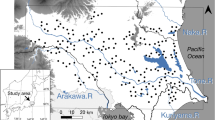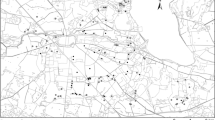Abstract
The biodiversity values of temporary pools in tropical ecosystems are poorly understood. Such wetlands are often threatened by agriculture. Constructed pools provide a means to mitigate for loss of natural pools but design features associated with restoration successful are not known. In this paper, we evaluated the effects of environmental variables at local (breeding pools) and regional spatial scales (landscape configuration) on species richness and abundance of anurans in heavily altered landscapes of southeastern Brazil. Frog and toad communities of 18 constructed temporary breeding pools were sampled every 2 weeks from October 2008 to March 2009. Two variables—hydroperiod and percentage of vegetation in the interior of the pools—explained 62% of species richness variation. Three other variables—pool area, distance of pools to forest fragments, and distance of pools to road—explained between 22 and 46% of the variation in frog and toad abundance. Our results indicate that local- and regional-scale variables, and their interaction, are important drivers of the structure of frog and toad communities in these agricultural landscapes. To facilitate amphibian conservation we suggest that cattle ranchers create and maintain heavily vegetated temporary pools near protected forest reserves as both a water source for livestock and breeding habitat for amphibians.


Similar content being viewed by others
References
AmphibiaWeb (2011) Information on amphibian biology and conservation. [web application]. Berkeley, California: AmphibiaWeb. Available via DIALOG, http://amphibiaweb.org/. Accessed 31 Jan 2011
Babbitt KJ, Baber MJ, Childers DL, Hocking D (2009) Influence of agricultural upland habitat type on larval anuran assemblages in seasonally inundated wetlands. Wetlands 29:294–301
Barcha SF, Arid FM (1971) Estudo da evapotranspiração na região norte-ocidental do estado de São Paulo. Revista de Ciências da Faculdade de Ciências e Letras 1:94–122
Becker CG, Fonseca CR, Haddad CFB, Batista RF, Prado PI (2007) Habitat split and the global decline of amphibians. Science 318:1775–1777
Beja P, Alcazar R (2003) Conservation of Mediterranean temporary ponds under agricultural intensification: an evaluation using amphibians. Biological Conservation 114:317–326
Bickford D, Ng TH, Qie L, Kudavidanage EP, Bradshaw CJA (2010) Forest fragment and breeding habitat characteristics explain frog diversity and abundance in Singapore. Biotropica 42:119–125
Bivant R, Anselin L, Assunção R, Berke O, Bernat A, Carvalho M, Chun Y, Dormann C, Dray S, Halbersma R, Krainski E, Lewin-Koh N, Tiefelsdorf M, Yu D (2009) spdep: Spatial dependence: weighting shemes, statistics and models. R package version 0.4-29. Available via DIALOG, http://cran.at.r-project.org/web/packages/spdep
Burne MR, Griffin CR (2005) Habitat associations of pool-breeding amphibians in eastern Massachusetts, USA. Wetlands Ecology and Management 13:247–259
Burnham KP, Anderson DR (1998) Model selection and inference. Springer, New York
Chevan A, Sutherland M (1991) Hierarchical partitioning. The American Statistician 45:90–96
Colwell RK (2004) EstimateS 8.20: Statistical estimation of species richness and shared species from samples. User’s guide and application. Department of Ecology and Evolutionary Biology, University of Connecticut, Storrs. Available via DIALOG, http://purl.oclc.org/estimates
Cushman SA (2006) Effects of habitat loss and fragmentation on amphibians: a review and prospectus. Biological Conservation 128:231–240
Duellman WE, Trueb L (1994) Biology of amphibians. The Johns Hopkins University Press, Baltimore
Egan RS, Paton PWC (2004) Within-pond parameters affecting ovoposition by wood frogs and spotted salamanders. Wetlands 24:1–13
Eigenbrod F, Hecnar SJ, Fahrig L (2008) The relative effects of road traffic and forest cover on anuran populations. Biological Conservation 141:35–46
Fahrig L, Pedlar JH, Pope SE, Taylor PD, Wegner JF (1995) Effect of road traffic on amphibian density. Biological Conservation 73:177–182
Findlay CS, Houlahan J (1997) Anthropogenic correlates of species richness in Southeastern Ontario Wetlands. Conservation Biology 11:1000–1009
Frost DR (2010) Amphibian species of the world: an online reference. Available via DIALOG, http://research.amnh.org/vz/herpetology/amphibia. Accessed 23 November 2010
Gibbs JP (1998) Amphibian movements in response to forest edges, roads, and streambeds in Southern New England. Journal of Wildlife Management 62:584–589
Hamer AJ, Parris KM (2011) Local and landscape determinants of amphibian communities in urban ponds. Ecological Applications 21:378–390
Herrmann HL, Babbitt KJ, Baber MJ, Congalton RG (2005) Effects of landscape characteristics on amphibian distribution in a forest-dominated landscape. Biological Conservation 123:139–149
Jansen DH (1997) Florestas tropicais secas. In: Wilson EO (ed) Biodiversidade, 1st edn. Editora Nova Fronteira, Rio de Janeiro, pp 166–176
Joly CA, Rodrigues RR, Metzger JP, Haddad CFB, Verdade LM, Oliveira MC, Bolzani VS (2010) Biodiversity conservation research, training, and policy in São Paulo. Science 11:1358–1359
Karraker NE, Gibbs JP (2009) Amphibian production in forested landscapes in relation to wetland hydroperiod: a case study of vernal pools and beaver ponds. Biological Conservation 142:2293–2302
Laan R, Verboom B (1990) Effects of pool size and isolation on amphibian communities. Biological Conservation 54:251–262
Legendre P (1993) Spatial autocorrelation: trouble or new paradigm? Ecology 74:1659–1673
Lichtenberg JS, King SL, Grace JB, Walls SC (2006) Habitat associations of chorusing anurans in the lower Mississipi river alluvial valley. Wetlands 26:736–744
Mac Nally R (2000) Regression and model-building in conservation biology, biogeography and ecology: the distinction between - and reconciliation of - ‘predictive’ and ‘explanatory’ models. Biodiversity and Conservation 9:655–671
Mac Nally R (2002) Multiple regression and inference in ecology and conservation biology: further comments on identifying important predictor variables. Biodiversity and Conservation 11:1397–1401
Myers N, Mittermeier RA, Mittermeier CG, Da Fonseca GAB, Kent J (2000) Biodiversity hotspots for conservation priorities. Nature 403:853–858
Nalon MA, Mattos IFA, Franco GADC (2008) Meio físico e aspectos da fragmentação da vegetação. In: Rodrigues RR, Joly CA, de Brito MCW, Paese A, Metzger JP, Casatti L, Nalon MA, Menezes N, Ivanauskas NM, Bolzani V, Bononi VLR (eds) Diretrizes para a restauração e conservação da biodiversidade no Estado de São Paulo, 1st edn. FAPESP, São Paulo, pp 15–24
Oliveira-Filho AT, Fontes MAL (2000) Patterns of floristic differentiation among Atlantic Forests in southeastern Brazil and the influence of climate. Biotropica 32:793–810
Otto CRV, Forester DC, Snodgrass JW (2007) Influences of wetland and landscape characteristics on the distribution of carpenter frogs. Wetlands 27:261–269
Pinheiro J, Bates D, DebRoy S, Sarkar D, R Core Team (2009) nlme: Linear and nonlinear mixed effects models. R package version 3.1-96, Available via DIALOG, http://cran.r-project.org/package=nlme
Prado VHM, Borges R, Silva FR, Tognolo TT, Rossa-Feres DC (2008) Amphibia, Anura, Hylidae, Phyllomedusa azurea: distribution extension. Check List 4:55–56
R Development Core Team (2011) R: A language and environment for statistical computing, reference index version 2.13.1. R Foundation for Statistical Computing, Vienna, Austria. Available via DIALOG, http://www.Rproject.org
Reh W, Seitz A (1990) The influence of land use on the genetic structure of populations of the common frog Rana temporaria. Biological Conservation 54:239–249
Rodrigues RR, Joly CA, de Brito MCW, Paese A, Metzger JP, Casatti L, Nalon MA, Menezes N, Ivanauskas NM, Bolzani V, Bononi VLR (2008) Diretrizes para conservação e restauração da biodiversidade no Estado de São Paulo. FAPESP, São Paulo
Rossa-Feres DC, Martins M, Marques OAV, Martins IA, Sawaya RJ, Haddad CFB (2008) Herpetofauna. In: Rodrigues RR, Joly CA, de Brito MCW, Paese A, Metzger JP, Casatti L, Nalon MA, Menezes N, Ivanauskas NM, Bolzani V, Bononi VLR (eds) Diretrizes para a restauração e conservação da biodiversidade no Estado de São Paulo, 1st edn. FAPESP, São Paulo, pp 82–94
Santos TG, Rossa-Feres DC, Casatti L (2007) Diversidade e distribuição espaço-temporal de anuros em região com pronunciada estação seca no sudeste do Brasil. Iheringia 97:37–49
Semlitsch RD, Bodie JR (1998) Are small, isolated wetlands expendable? Conservation Biology 12:1129–1133
Shulse CD, Semlitsch RD, Trauth KM, Williams AD (2010) Influences of design and landscape placement parameters on amphibian abundance in constructed wetlands. Wetlands 30:915–928
Silva FR, Rossa-Feres DC (2007) The use of forest fragments by open-area anurans (Amphibia) in northwestern São Paulo State, Brazil. Biota Neotropica 7:141–148
Silva FR, Rossa-Feres DC (2011) Influence of terrestrial habitat isolation on the diversity and temporal distribution of anurans in an agricultural landscape. Journal of Tropical Ecology 27:327–331
Silva FR, Prado VHM, Vasconcelos TS, Santos TG, Rossa-Feres DC (2009) Amphibia, Anura, Microhylidae, Chiasmocleis albopunctata: filling gap and geographic distribution map. Check List 5:314–316
Silva FR, Prado VHM, Rossa-Feres DC (2010) Amphibia, Anura, Hylidae, Dendropsophus melanargyreus (Cope, 1887): distribution extension, new state record and geographic distribution map. Check List 6:402–404
SMA/IF (Secretaria do Meio Ambiente / Instituto Florestal) (2005) Inventário florestal da vegetação natural do Estado de São Paulo. Imprensa Oficial do Estado de São Paulo, São Paulo
Snodgrass JW, Komoroski MJ, Bryan L Jr, Burger J (2000) Relationships among isolated wetland size, hydroperiod, and amphibian species richness: implications for wetland regulations. Conservation Biology 14:414–419
Sutherland RW, Dunning PR, Baker WM (2010) Amphibian encounter rates on roads with different amounts of traffic and urbanization. Conservation Biology 24:1626–1635
Van Buskirk J (2005) Local and landscape influence on amphibian occurrence and abundance. Ecology 86:1936–1947
Vasconcelos TS, Rossa-Feres DC (2005) Diversidade, distribuição espacial e temporal de anfíbios anuros (Amphibia, Anura) na região noroeste do estado de São Paulo, Brasil. Biota Neotropica 5:137–150
Wassens S, Hall A, Osborne W, Watts RJ (2010) Habitat characteristics predict occupancy patterns of the endangered amphibian Litoria raniformis in flow-regulated flood plain wetlands. Austral Ecology 35:944–955
Wellborn GA, Skelly DK, Werner EE (1996) Mechanisms creating community structure across a freshwater habitat gradient. Annual Review of Ecology and Systematics 27:337–363
Werner EE, Relyea RA, Yurewicz KL, Skelly DK, Davis CJ (2009) Comparative landscape dynamics of two anuran species: climate-driven interaction of local and regional processes. Ecological Monographs 79:503–521
Zuur AF, Ieno EN, Walker NJ, Saveliev AA, Smith GM (2009) Mixed effects models and extensions in ecology with R. Springer, New York
Acknowledgments
This work was supported by Fundação de Amparo a Pesquisa do Estado de São Paulo (FAPESP - grants 07/50738-5 and 04/04820-3); Coordenação de Aperfeiçoamento de Pessoal de Nível Superior (CAPES) - Programa de Doutorado no País com Estágio no Exterior (PDEE - grant 1186/09-4), and Conselho Nacional de Desenvolvimento Científico e Tecnológico (CNPq - grant to D.C. Rossa-Feres).
Author information
Authors and Affiliations
Corresponding author
Electronic supplementary material
Below is the link to the electronic supplementary material.
ESM 1
(DOC 264 kb)
Rights and permissions
About this article
Cite this article
da Silva, F.R., Gibbs, J.P. & Rossa-Feres, D.d.C. Breeding Habitat and Landscape Correlates of Frog Diversity and Abundance in a Tropical Agricultural Landscape. Wetlands 31, 1079–1087 (2011). https://doi.org/10.1007/s13157-011-0217-0
Received:
Accepted:
Published:
Issue Date:
DOI: https://doi.org/10.1007/s13157-011-0217-0




